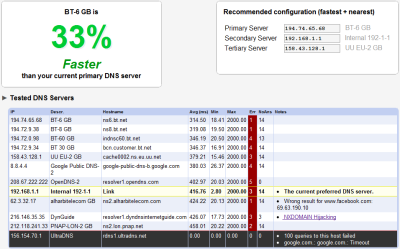One of the factors that dictates browsing speed is the time it takes to do a DNS lookup – that is, convert a domain name such as google.com into an IP address such as 209.85.227.105. Generally most people use the DNS servers operated by their ISP. Usually this is fine, but sometimes ISP DNS servers can be unreliable, and they’re not always the fastest choice.
There are many free public DNS services, such as OpenDNS and search giant Google’s Public DNS, but it’s difficult to know which one is best for you. Enter NameBench, a free cross-platform tool which tests a raft of public DNS services using either your browser history or a list of top domains. Once the tests are complete, you receive a summary of the results including suggested primary, secondary and tertiary servers:

So if you’ve got a few minutes to spare, why not see if you can shave a few milliseconds from your page load times?

